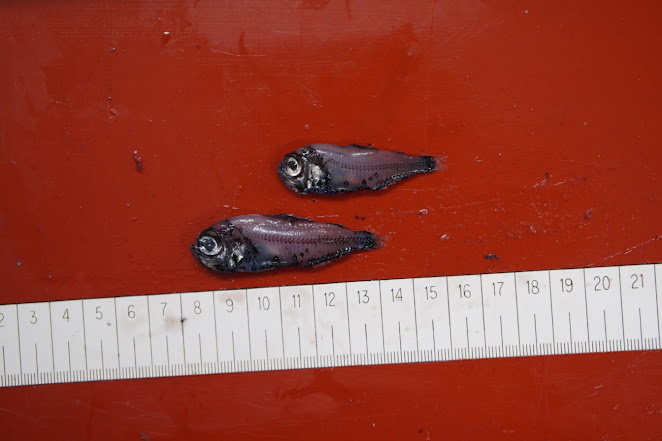Op zondagavond 18:23 stoppen we voor CTD station 15 en doen op dezelfde locatie een miknet-trek (nr. 11; 11 55.20N-13.02W). Al ver voordat we bij de rand van het continentale plat komen, zien we echo's van blauwe wijting. We vissen hierop 's nachts om 1:00 UTC (trek7). De vangst bestaat uit blauwe wijting en enkele procenten meso-pelagische vis. We vangen ook een zevenarmige octopus (Haliphron atlanticus). De maximale lengte van deze soort is 2.9m en daarmee is het de grootste octopus ter wereld. Hij heet zo omdat een van de armen, die gebruikt wordt bij de voortplanting, opgerold zit in een holte onder het rechteroog. Helaas is hij niet erg stevig en kom hij in brokstukken aan boord.
On Sunday evening 18:23 we stop for CTD station 15 and do a miknet pull at the same location (no. 11; 11 55.20N-13.02W). Long before we get to the edge of the continental shelf, we already see echoes of blue whiting. We fish at this at night at 1:00 UTC (trek7). The catch consists of blue whiting and a few percent of meso-pelagic fish. We also catch a seven-armed octopus (Haliphron atlanticus). The maximum length of this species is 2.9m, making it the largest octopus in the world. It is so named because one of the arms, which is used for reproduction, is curled up in a hollow under the right eye. Unfortunately, it is not very sturdy and comes on board in fragments.
 |
| Trek 7, 28 maart 55.22N-11.34W, 815 kg blauwe wijting. - Haul 7, 28 March 55.22N-11.34W, 815kg blue whiting. |
 |
| In de vangst van trek 7 zit ook deze zwarte barracudina (Macroparalepis nigra). - The catch of haul 7 also includes this black barracudina (Macroparalepis nigra). |
Direct na het halen van het net voor trek 7, voeren we een miknet trek uit (nr. 12) om (3:16 UTC; 55.23N-11.18W). Immediately after hauling for haul 7, we carry out a miknet haul (No. 12) at (3:16 UTC; 55.23N-11.18W).
 |
| Leptocephalus larve van een congeraal in miknet-trek 12. - Leptocephalus larva of a conger eel in miknet haul 12. |
Om 7:40 doen we een trek met het miknet (nr. 13) om 7:40 op 55.22-10.38W. Om 11:53 komen we bij de rand van het continentale plat. De echo's van de blauwe wijting laag op 450m worden minder sterk. Er verschijnen rode schooltjes boven de bodem wanneer de diepte ongeveer 350m is. We vissen op deze akoestische aantekeingen in trek 8 . De vangst bestaat uit blauwe wijting en horsmakreel.
At 7:40 we do a tow with the miknet (no. 13) at 7:40 at 55.22-10.38W. At 11:53 we arrive at the edge of the continental shelf. The echoes of the blue whiting layer at 450m become less strong. Red schools appear above the bottom when the depth is about 350m. We're fishing for these acoustic recordings in haul 8. The catch consists of blue whiting and horse mackerel.
 |
| Een grote, vrijwel doorzichtige hyperide amphipode van 35mm in miknet-trek 13. - A large, nearly transparent 35mm hyperid amphipod in mik net tow 13. |
 |
| Blauwe wijting concentraties zoals we ze tot nu toe gevonden hebben. Deze kaart is gemaakt met de voorlopige resultaten van de Tridens, zonder de data van de andere deelnemende onderzoeksschepen tijdens dit onderzoek. - Blue whiting concentrations as we have found them so far. This map was created with the preliminary results of the Tridens, without the data from the other participating research vessels during this study. |












































